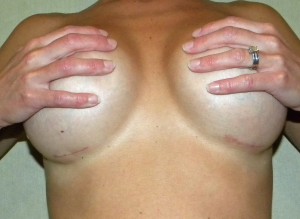Breast augmentation remains a highly requested body contouring procedure. Its popularity is undoubtably due to both its immediate effect and effectiveness at achieving its goal. The operation is a device-driven procedure in which the implant is completely responsible for the success of the procedure. Patients have the choice of saline or silicone gel implants for their breast augmentation.
Since the re-introduction of silicone gel breast implants in 2006, they have now largely supplanted the use of saline in my Indianapolis plastic surgery practice. Despite a handful of advantages for the use of silicone, there does remain one disadvantage. That is the need to use a breast incision to place them. Because silicone gel breast implants are pre-filled, a direct breast incision is needed. Due to their pre-filled sizes, only a lower breast crease or fold incision can usually be used.

The goal of a lower fold incision in breast augmentation is to put it in the exact fold line and to make it as short in length as possible. Getting the incision exactly in the inframammary fold is, most of the time, a preoperative estimate. Most breast augmentations require the lower breast fold to be lowered. Making the incision in the existing breast fold for most patients, therefore, will have it being above the fold after the operation is completed and the implants settle with time. This is why it is often marked a little lower than one’s natural fold when the breasts are smaller. Also, while breast implants are much wider than the incision pictured, their suppleness and moldability allow them to be put through a much smaller incision than their base width. The length of the incision needed is usually about a quarter to a third of the width of the breast implant.
While the lower breast fold incision in breast augmentation will be red for several months, it does fade into a fine white line. In darker pigmented patients, the scar may be initially associated with some hyperpigmentation which will fade in most patients over time.
Dr. Barry Eppley
Indianapolis, Indiana


